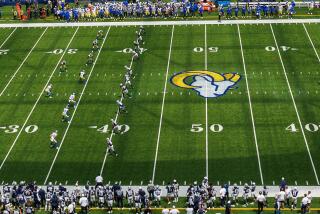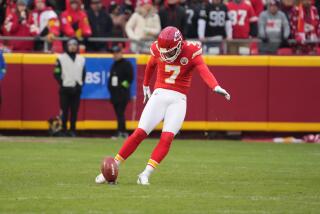The Physics of Football
- Share via
You see it often in football games. The quarterback throws a long pass down the sideline. The wide receiver catches the ball, but is a step or two out of bounds and the pass is incomplete.
A misjudgment by the quarterback? In part, yes. But another important factor is the tendency of a long pass to curve two or three yards or more near the end of its flight, says aerospace engineer William J. Rae of the State University of New York at Buffalo.
A few quarterbacks seem to be intuitively aware of the ball’s tendency to veer off-direction at the end, but most aren’t.
“I talked to [ex-Packer] Bart Starr and [ex-Cowboy] Roger Staubach, and they did not know anything about it,” Rae said.
In fact, Rae himself did not know about it until recently. Preliminary studies he did four years ago seemed to indicate that the ball flew straight and true to its target. It was only when he recently performed wind tunnel testing of the ball that he detected the presence of a curvature in its path.
“It is not unlike the curve on a baseball,” he said, “but it goes the other way.” A long pass by a right-handed quarterback curves to the right.
One thrown by a lefty curves to the left. The curvature arises from a complex interaction of forces that is only now beginning to be understood.
Despite Americans’ fascination with the Sunday afternoon sport, there have been virtually no studies of the forces acting on a football.
“There has been lots of work done on baseballs, golf balls and tennis balls, but I don’t know of anybody else but Bill” who has studied footballs, said aeronautical engineer Jani Pallis of Cislunar Aerospace Inc. in San Francisco, a company that specializes in aerodynamics for sports.
“It’s a difficult ball to study, much more so than round balls, because of the wobble,” she said. “It’s a difficult problem to make it spin in a manner that resembles how it is thrown.”
Rae got interested in footballs because he teaches a course in aircraft flight dynamics. “I thought I could capture their attention if I brought in a football and told them how it flew.”
But when he started searching the literature, he was amazed to find almost nothing about football physics.
“It turns out the flight of a football is almost as complicated as the flight of an airplane, but we knew much less about the football,” he said.
With a small amount of funding from Wilson Sporting Goods, Rae began with computer simulations of a football’s flight. To inject some real-world data into the calculations, he performed detailed frame-by-frame analyses of Staubach’s famous “Hail Mary” pass in the 1976 Dallas Cowboys-New York Giants playoff game.
To do the analysis correctly, he obtained architects’ drawings of Giants Stadium in East Rutherford, N.J., to accurately discern the geometry of the field and to account for where the camera operator probably was standing during filming.
“The film gave me information on the time of flight, the distance the ball traveled and the spin-to-wobble ratio,” Rae said.
*
Even Good Passes Wobble
A football, when thrown properly, spins on its axis--an imaginary line drawn through the two tips--and also wobbles, the nose rotating around the line of flight. Rae found that the ball spins nine times for every five times it wobbles, a ratio that holds pretty constant no matter how the pass is thrown.
He also took a quarterback at the university into a gymnasium and had him throw passes directly at a camera at the other end of the floor.
Tracing the flight of the ball in those pictures, it is easy to see that it curves a couple of yards at the end.
That fact was long known to the military.
“People who launch [artillery] shells call it drift, and allow for it,” Rae said. “It’s common to any spinning missile on a highly arched trajectory.”
But it was not thought to happen with a football.
The clinching evidence came in wind tunnel tests.
“Nobody else has done it yet. It’s not an easy experiment to do,” Rae said.
To put a football on a mount “and spin the ball at 600 revolutions per minute and not have it fall off is difficult,” he added.
*
The Gyroscope Principle
To do it, Rae took a regulation NFL ball, cut the back end off about an inch from the tip, and filled it with a polyurethane foam that inflated the ball to normal size without adding much weight. He then hollowed the ball out, leaving just enough foam to keep it inflated, and inserted a small electric motor to spin the ball.
The physics he observed is complicated and is presented in two soon-to-be-published papers. In layman’s terms, however, there are three primary forces acting on the football. The first is a lift force generated by air colliding with the underside of the ball, near the nose.
That force tends to make the ball tumble end over end. To counter it, the quarterback puts spin on the ball, which makes the ball act like a gyroscope.
That prevents the nose from rising, but tends to make it move to the right for a right-handed quarterback or to the left for a left-hander.
“This is the fundamental gyroscope principle: If a body is spun about one axis and torqued [turned] about a second axis, it will respond by turning about the third axis,” he said. “Anyone who has ever used a leaf blower can feel this when they try to turn it.”
*
Gravity’s Pull
A third torque is generated by the fact that the ball is being rotated forward by gravity. Typically, its nose is pointed upwards at about 30 degrees when it is thrown, and rotates so that the nose is pointed 30 degrees down when it is caught. That force tends to turn it to the left (for a right-handed quarterback) and was once thought to cancel out the rightward torque, making the ball fly straight.
Rae’s new studies show, however, that the left torque is small and that the ball’s flight does, indeed, curve.
Will the new findings affect the sport? Probably not, Rae concedes.
“But in a sport where outcomes are decided by inches, who knows?”
*
Maugh can be reached at thomas.maugh@latimes.com.






